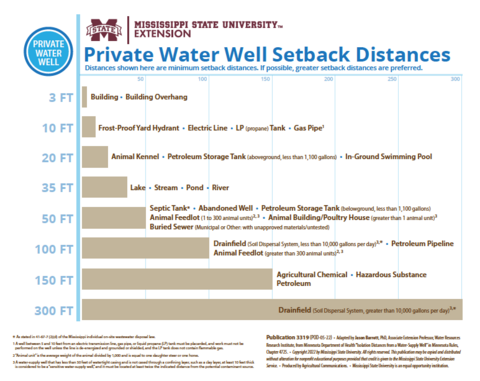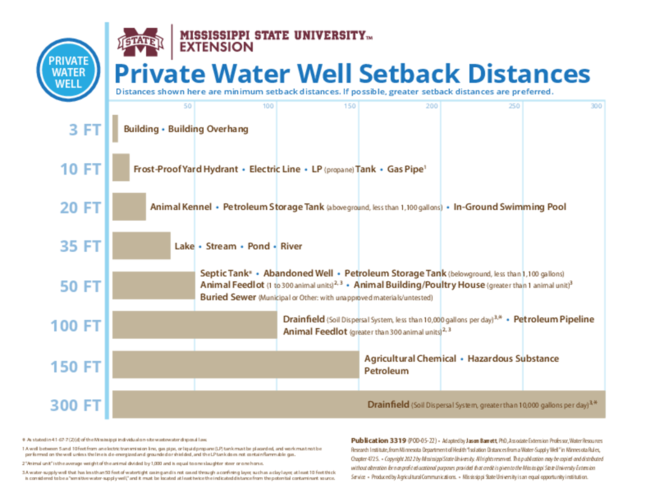P3319
Private Water Well Setback Distances

Private Water Well Setback Distances
Distances are minimum setback distances. If possible, greater setback distances are preferred.
3 feet
- Building
- Building overhang
10 feet
- Frost-proof yard hydrant
- Electric line
- LP (propane) tank
- Gas pipe1
20 feet
- Animal kennel
- Petroleum storage tank (aboveground, less than 1,100 gallons)
- In-ground swimming pool
35 feet
- Lake
- Stream
- Pond
- River
50 feet
- Septic tank*
- Abandoned well
- Petroleum storage tank (belowground, less than 1,100 gallons)
- Animal feedlot (1 to 300 animal units)2 , 3
- Animal building/poultry house (greater than 1 animal unit)3
- Buried sewer (municipal or other: with unapproved materials/untested)
100 feet
- Drainfield (soil dispersal system, less than 10,000 gallons per day)*
- Petroleum pipeline
- Animal feedlot (greater than 300 animal units)2, 3
150 feet
- Agricultural chemical
- Hazardous substance
- Petroleum
300 feet
- Drainfield (soil dispersal system, greater than 10,000 gallons per day)* 3
1A well between 5 and 10 feet from an electric transmission line, gas pipe, or liquid propane (LP) tank must be placarded, and work must not be performed on the well unless the line is de-energized and grounded or shielded, and the LP tank does not contain flammable gas.
2“Animal unit” is the average weight of the animal divided by 1,000 and is equal to one slaughter steer or one horse.
3A water-supply well that has less than 50 feet of watertight casing and is not cased through a confining layer, such as a clay layer, at least 10 feet thick is considered to be a “sensitive water-supply well,” and it must be located at least twice the indicated distance from the potential contaminant source.
Publication 3319 (POD-08-25)
Adapted by Jason Barrett, PhD, Associate Extension Professor, Water Resources Research Institute, from Minnesota Department of Health “Isolation Distances from a Water-Supply Well” in Minnesota Rules, Chapter 4725.
The Mississippi State University Extension Service is working to ensure all web content is accessible to all users. If you need assistance accessing any of our content, please email the webteam or call 662-325-2262.
